Abstract
Mutations and amplifications of the Ppm1d gene encoding Wip1 phosphatase have been found in various tumors. Recent studies have shown that the presence of Wip1 stable mutant after chemotherapy suggests that Wip1 is involved in the resistance of malignant cells to chemotherapeutic drugs. In the present work, we investigated the role of Wip1 in the response of colon cancer cells to the antitumor drugs 5-fluorouracil and oxaliplatin. Cell lines with an increased level of Ppm1d expression were obtained with acquired using lentiviral transduction. It has been shown that Wip1 overexpression maintains the cell viability of cells exposed to oxaliplatinum, while deletion of the Ppm1d gene decreases the viability and clonogenicity both under the combined and single exposure to these drugs. These findings suggest that an increased Wip1 level in cancer cells during chemotherapy may contribute to the development of cancer cell resistance to antitumor therapy. Methods aimed at reducing the Wip1 level will increase the efficiency of colon cancer treatment.





Similar content being viewed by others
REFERENCES
Bulavin, D.V., Demidov, O.N., Saito, S., Kauraniemi, P., Phillips, C., Amundson, S.A., Ambrosino, C., Sauter, G., Nebreda, A.R., Anderson, C.W., Kallioniemi, A., Fornace, A.J.Jr., and Appella, E., Amplification of PPM1D in human tumors abrogates p53 tumor-suppressor activity, Nat. Genet., 2002, vol. 31, pp. 210–215.
Castellino, R.C., De, Bortoli, M., Lu, X., Moon, S.H., Nguyen, T.A., Shepard, M.A., Rao, P.H., Donehower, L.A., and Kim, J.Y., Medulloblastomas overexpress the p53-inactivating oncogene WIP1/PPM1D, J. Neuro-Oncol., 2008, vol. 86, pp. 245–256.
Chen, Z., Wang, L., Yao, D., Yang, T., Cao, W.M., Dou, J., Pang, J.C., Guan, S., Zhang, H., Yu, Y., Zhao, Y., Wang, Y., Xu, X., Shi, Y., Patel, R., Zhang, H., Vasudevan, S.A., Liu, S., Yang, J., and Nuchtern, J.G., Wip1 inhibitor GSK2830371 inhibits neuroblastoma growth by inducing Chk2/p53-mediated apoptosis, Sci. Rep., 2016, vol. 6, p. 38011.
Coombs, C.C., Zehir, A., Devlin, S.M., Kishtagari, A., Syed, A., Jonsson, P., Hyman, D.M., Solit, D.B., Robson, M.E., Baselga, J., Arcila, M.E., Ladanyi, M., Tallman, M.S., Levine, R.L., and Berger, M.F., Therapy-related clonal hematopoiesis in patients with non-hematologic cancers is common and associated with adverse clinical outcomes, Cell Stem Cell, 2017, vol. 21, pp. 374–382.
Demidov, O.N., Kek, C., Shreeram, S., Timofeev, O., Fornace, A.J., Jr., Appella, E., and Bulavin, D.V., The role of the MKK6/p38 MAPK pathway in Wip1-dependent regulation of ErbB2-driven mammary gland tumorigenesis, Oncogene, 2007, vol. 26, pp. 2502– 2506.
Dimri, G.P., Lee, X., Basile, G., Acosta, M., Scott, G., Roskelley, C., Medrano, E.E., Linskens, M., Rubelj, I., Pereira-Smith, O., Peacocke, M., and Campisi, J., A Biomarker that identifies senescent human cells in culture and in aging skin in vivo, Proc. Natl. Acad. Sci. U. S. A., 1995, vol. 92, pp. 9363–9367.
Ewald, J.A., Desotelle, J.A., Wilding, G., and Jarrard, D.F., Therapy-induced senescence in cancer, J. Natl. Cancer Inst., 2010, vol. 102, pp. 1536–1546.
Fiscella, M., Zhang, H., Fan, H.L., Sakaguchi, K., Shen, S., Mercer, W.E., Vande, Woude, G.F., O’Connor, P.M., and Apella, E., Wip1, a novel human protein phosphatase that is induced in response to ionizing radiation in a P53-dependent manner, Proc. Natl. Acad. Sci. U. S. A., 1997, vol. 94, pp. 6048–6053.
Gibson, C.J., Lindsley, R.C., Tchekmedyian, V., Mar, B.G., Shi, J., Jaiswal, S., Bosworth, A., Francisco, L., He, J., Bansal, A., Morgan, E.A., Lacasce, A.S., Freedman, A.S., Fisher, D.C., Jacobsen, E., Armand, P., Alyea, E.P., Koreth, J., Ho, V., Soiffer, R.J., Antin, J.H., Ritz, J., Nikiforow, S., Forman, S.J., Michor, F., Neuberg, D., Bhatia, R., Bhatia, S., and Ebert, B.L., Clonal hematopoiesis associated with adverse outcomes after autologous stem-cell transplantation for lymphoma, J. Clin. Oncol., 2017, vol. 35, pp. 1598–1605.
Giuliani, J. and Bonetti, A., First-line therapies in metastatic colorectal cancer: integrating clinical benefit with the costs of drugs, Int. J. Colorectal Dis., 2018, vol. 33, pp. 1505– 1516.
Goloudina, A.R., Kochetkova, E.Y., Pospelova, T.V., and Demidov, O.N., Wip1 phosphatase: between p53 and MAPK kinases pathways, Oncotarget, 2016, vol. 7, pp. 31563– 31571.
Hsu, J.I., Dayaram, T., Tovy, A., De, Braekeleer, E., Jeong, M., Wang, F., Zhang, J., Heffeman, T.P., Gera, S., Kovacs, J.J., Marszalek, J.R., Bristow, C., Yan, Y., Garcia-Manero, G., Kantarjian, H., Vassiliou, G., Futreal, P.A., Donehower, L.A., Takahashi, K., and Goodell, M.A., PPM1D mutations drive clonal hematopoiesis in response to cytotoxic chemotherapy, Cell Stem Cell, 2018, vol. 23, pp. 700–713.
Kochetkova, E.Yu., Pospelova, T.V., and Demidov, O.N., Depletion of Wip1 phosphatase sensitizes murine skin cells to UV-B irradiation, Cell Tissue Biol., 2016, vol. 10, no. 4, pp. 290–296.
Liang, C., Guo, E., Lu, S., Wang, S., Kang, C., Chang, L., Liu, L., Zhang, G., Wu, Z., Zhao, Z., Ma, S., Wang, L., and Jiao, B.H., Overexpression of wild-type P53-induced phosphatase 1 confers poor prognosis of patients with gliomas, Brain Res., 2012, vol. 1444, pp. 65–75.
Natrajan, R., Lambros, M.B., Rodríguez-Pinilla, S.M., Moreno-Bueno, G., Tan, D.S.P., Marchió, C., Vatcheva, R., Rayter, S., Mahler-Araujo, B., Fulford, L.G., Hungermann, D., Mackay, A., Grigoriadis, A., Fenwick, K., Tamber, N., Hardisson, D., Tutt, A., Palacios, J., Lord, C.J., Buerger, H., Ashworth, A., and Reis-Filho, J.S., Tiling path genomic profiling of grade 3 invasive ductal breast cancers, Clin. Cancer Res., 2009, vol. 15, pp. 2711–2722.
Peng, T.S., He, Y.H., Nie, T., Hu, X.D., Lu, H.Y., Yi, J., Shuai, Y.F., and Luo, M., PPM1D is a prognostic marker and therapeutic target in colorectal cancer, Exp. Ther. Med., 2014, vol. 8, no. 2, pp. 430 – 434.
Pharoah, P.D.P., Song, H., Dicks, E., Intermaggio, M.P., Harrington, P., Baynes, C., Alsop, K., Bogdanova, N., Cicek, M.S., Cunningham, J.M., Fridley, B.L., Gentry-Maharaj, A., Hillemanns, P., Lele, S., Lester, J., McGuire, V., Moysich, K.B., Poblete, S., Sieh, W., Sucheston-Campbell, L., Widschwendter, M., Whittemore, A.S., Dörk, T., Menon, U., Odunsi, K., Goode, E.L., Karlan, B.Y., Bowtell, D.D., Gayther, S.A., Ramus, S.J., and Australian Ovarian Cancer Study Group; Ovarian Cancer Association Consortium, PPM1D mosaic truncating variants in ovarian cancer cases may be treatment-related somatic mutations, J. Natl. Cancer Inst., 2016, vol. 108, no. 3. https://doi.org/10.1093/jnci/djv347
Richter, M., Dayaram, T., Gilmartin, A.G., Ganji, G., Pemmasani, S.K., Van, Der, Key, H., Shohet, J.M., Donehower, L.A., and Kumar, R., WIP1 phosphatase as a potential therapeutic target in neuroblastoma, PLoS One, 2015, vol. 10. e0115635. https://doi.org/10.1371/journal.pone.0115635
Saito-Ohara, F., Imoto, I., Inoue, J., Hosoi, H., Nakagawara, A., Sugimoto, T., and Inazawa, J., PPM1D is a potential target for 17q gain in neuroblastoma, Cancer Res., 2003, vol. 63, pp. 1876–1883.
Shreeram, S., Demidov, O.N., Hee, W.K., Yamaguchi, H., Onishi, N., Kek, C., Timofeev, O.N., Dudgeon, C., Fornace, A.J., Anderson, C.W., Minami, Y., Appella, E., and Bulavin, D.V., Wip1 phosphatase modulates ATM-dependent signaling pathways, Mol. Cell, 2006, vol. 23, pp. 757–764.
Song, J.Y., Ryu, S.H., Cho, Y.M., Kim, Y.S., Lee, B.M., Lee, S.W., and Choi, J., Wip1 suppresses apoptotic cell death through direct dephosphorylation of BAX in response to gamma-radiation, Cell Death Dis., 2013, vol. 4. e744. https://doi.org/10.1038/cddis.2013.252
Steensma, D.P., Bejar, R., Jaiswal, S., Lindsley, R.C., Sekeres, M.A., Hasserjian, R.P., and Ebert, B.L., Clonal hematopoiesis of indeterminate potential and its distinction from myelodysplastic syndromes, Blood, 2015, vol. 126, no. 1, pp. 9–16.
Tan, D.S., Lambros, M.B., Rayter, S., Natrajan, R., Vatcheva, R., Gao, Q., Marchio, C., Geyer, F.C., Savage, K., Parry, S., Fenwick, K., Tamber, N., Mackay, A., Dexter, T., Jameson, C., McCluggage, W.G., Williams, A., Graham, A., Faratian, D., El-Bahrawy, M., Paige, A.J., Gabra, H., Gore, M.E., Zvelebil, M., Lord, C.J., Kaye, S.B., Ashworth, A., and Reis-Filho, J.S., PPM1D is a potential therapeutic target in ovarian clear cell carcinomas, Clin. Cancer Res., 2009, vol. 15, pp. 2269–2280.
Xia, Y., Ongusaha, P., Lee, S.W., and Liou, Y.C., Loss of Wip1 sensitizes cells to stress- and DNA damage-induced apoptosis, J. Biol. Chem., 2009, vol. 284, pp. 1742 –17437.
Yu, E., Anh, Y.S., Jang, S.J., Kim, M.J., Yoon, H.S., Gong, G., and Choi, J., Overexpression of the Wip1 gene abrogates the p38 MAPK/p53/Wip1 pathway and silences p16 expression in human breast cancers, Breast Cancer Res. Treat., 2007, vol. 101, pp. 269– 278.
Zubova, Yu. G., Bykova, T.V., Zubova, S.G., Abramova, M.V., Aksenov, N.D., Pospelov, V.A., and Pospelova, T.V., Induction of premature senescence program by an inhibitor of histone deacetylase sodium butyrate in normal and transformed rat fibroblasts, Tsitologiia, 2005, vol. 47, no. 12, pp. 1055—1062.
Funding
This study was supported by the Russian Foundation for Basic Research, project no. 17-04-01592.
Author information
Authors and Affiliations
Corresponding author
Ethics declarations
The authors declare that they have no conflict of interest. This article does not contain any studies involving animals or human participants performed by any of the authors.
Additional information
Translated by I. Fridlyanskaya
Abbreviations: WT—wild-type cells, Wip1On—cells with Wip1 overexpression, Wip1KO—cells with Wip1 deletion, FU—5-fluorouracil, OP—oxaliplatinum.
Rights and permissions
About this article
Cite this article
Kochetkova, E.Y., Grigorash, B.B. & Demidov, O.N. Sensitivity of Cells with Various Levels of Ppm1d Expression to Classical Chemotherapeutic Drugs for Colorectal Cancer Treatment. Cell Tiss. Biol. 13, 344–352 (2019). https://doi.org/10.1134/S1990519X19050043
Received:
Revised:
Accepted:
Published:
Issue Date:
DOI: https://doi.org/10.1134/S1990519X19050043




